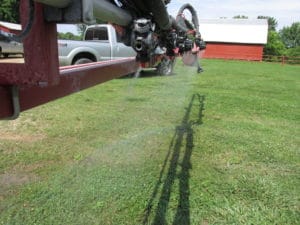 With the Xtend technology now available, hopefully everybody is gearing up with the correct nozzles and application knowledge needed to be successful. Although there are other application requirements in place with the new Xtendimax™ (www.xtendimaxapplicationrequirements.com) and Engenia™ (www.engeniatankmix.com) herbicide labels, the single most important thing you can do to steward this technology is equip your sprayer with the correct nozzles.
With the Xtend technology now available, hopefully everybody is gearing up with the correct nozzles and application knowledge needed to be successful. Although there are other application requirements in place with the new Xtendimax™ (www.xtendimaxapplicationrequirements.com) and Engenia™ (www.engeniatankmix.com) herbicide labels, the single most important thing you can do to steward this technology is equip your sprayer with the correct nozzles.
Nozzles really can make all the difference making an on-target application. Simply put, when the diameter of a spray droplet is doubled, the weight of that spray droplet is increased 8X. This would be about the same weight difference between a softball and a 4lb bowling ball.
Recommendations for each herbicide with this technology advise using specific nozzles that produce extremely coarse (XC) or ultra coarse (UC) droplet sizes. Though these nozzles work well with glyphosate, dicamba, and 2,4-D, they are NOT going to provide effective weed control when applying contact herbicides such as Flexstar, Gramoxone, Liberty, etc. This means applicators will need to have turrets on their booms where they can quickly change nozzles from say a Spraying Systems TTI or Wilger DR nozzle when spraying Engenia to a Spraying systems AIXR or Wilger SR nozzle when spraying Liberty.
Particularly with contact herbicides, when applications are being made to Palmer amaranth that is borderline too large consider changing to nozzles that have dual fans and/or put out smaller droplets to maximize control. Refer back to: https://news.utcrops.com/?p=11652. For tank mixes (check websites for approval prior to tank mixing) ALWAYS utilize approved nozzles that reduce drift when Xtendimax or Engenia are in the tank.
Fortunately, each herbicide now has a few nozzle options available for applicators to choose. However, there are some important things to consider prior to selecting a nozzle for your rig. The first thing to consider is whether or not your sprayer is equipped with pulse-width modulation (PWM). If your sprayer IS NOT equipped with PWM, your rate controller is likely pressure regulated and you need to consider the approved pressure ranges for making dicamba applications. For example, of the 20 nozzles currently listed on the Xtendimax website, only 8 allow for more than 20 lb of pressure fluctuation and 7 only allow for 10 lb of pressure fluctuation. Is less than 10 or 20 lb of pressure fluctuation realistic when making applications over hills and across rough areas? The Greeleaf TDXL-D11005 & 06 and the TeeJet TTI 11003, 04, & 05 allow for applications to be made from 20-60 PSI and offer the most flexibility. The general pick of the litter would be the aforementioned TTIs, as they are compatible with the Xtendimax and Engenia labels, offer the most drift reduction, and have achievable pressure ranges.
However, the TTI and TDXL (and others) are air-induction nozzles, making them incompatible with PWM rate control systems. For these systems you can either turn the PWM off (essentially becomes a pressure regulated system) OR consider the Wilger DR 110-10. This nozzle is approved on both the Xtendimax and Engenia labels and compatible with the PWM system. While the pressure range for dicamba applications with this nozzle is smaller, it’s not as important because the pressure variation is much smaller with these systems.
One final point is that UT research has shown that when you are not applying dicamba, a blended PWM nozzle set-up with a Wilger DR (PWM) paired with a smaller (110-02) Wilger SR (constant) is one of the most effective nozzle set ups for applying contact herbicides. This type of system can be quickly changed by the operator from a blended PWM (DR/SR) to a standard PWM (DR) and offers one of the most flexible options to quickly change back and forth from an effective contact herbicide application to an on-label Xtendimax or Engenia application.

